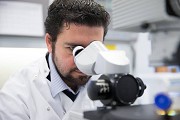Authors
A D Tsaousis2; C N Miller2; I R Brown2; B Blakeman2; J Povey2; W F Xue2; M Michaelis2; M Price2; J Cinatl jr1; 1 Klinikum der Goethe-Universität; 2 University of KentDiscussion
Cryptosporidiosis is a worldwide disease, second only to Rotavirus as the leading cause of childhood diarrhoeal mortality. The causative agent, Cryptosporidium, is a parasite belonging to apicomplexans and like many of them lack sufficient treatments, both preventative and curative. Similarly, experimentally proven knowledge of Cryptosporidium biology is also thin on the ground. A significant reason for this lack of treatment and data is the difficulties faced with obtaining the parasite and the lack of sufficient in-vitro models of infection to study it.
We present, a new in-vitro cell culture for the propagation of Cryptosporidium parvum that significantly exceeds the production and longevity of the previous gold-standard cell type of HCT-8 in all fields. We have demonstrated that the new cell culture infected with C. parvum produces between 5-10x more parasites during their life span than HCT-8, displaying significantly longer life spans until total culture senescence and as a result of this are significantly easier to handle, more robust and cost-effective. By utilising a broad, multi-disciplined approach, we conclusively show that the oocysts produced by these cell cultures are both morphologically and biochemically identical to those provided by animal models. Our proposed culturing system will change the future of Cryptosporidium research.

